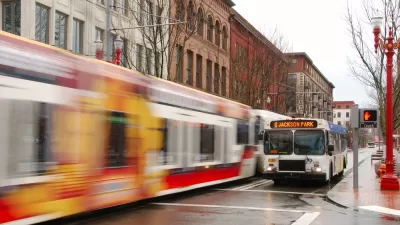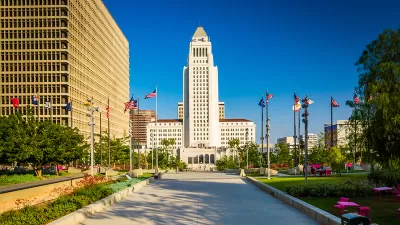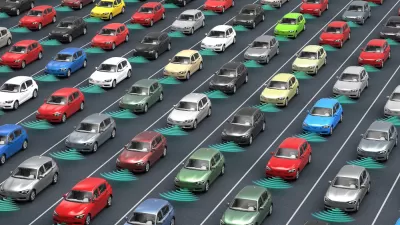The newest Drew Carey video at Reason.tv—Mexicans and Machines: Why Its Time to Lay Off NAFTA—is (IMHO) brilliant, and triggered more than a couple of thoughts about how technology and progress creates practical challenges for planning.
The newest Drew Carey video at Reason.tv-Mexicans and Machines: Why Its Time to Lay Off NAFTA-is (IMHO) brilliant, and triggered more than a couple of thoughts about how technology and progress creates practical challenges for planning.
The point of the seven minute clip, which is also an economically sound analysis, is the following: Machines have done far more to "displace" labor than international trade (and created tremendous economic value in the process). Criticism of NAFTA is really political campaign fodder, pandering to populist economic illiteracy. Why, Drew asks, if we're serious about the "threat" of Mexican (Canadian, Chinese, Indian .) labor on America's workforce, aren't we "demanding" a ban on the real culprit of technological progress? (Well, okay, there are some people in the Animal, Vegetable, Miracle/Kuntsler camp that probably want to do this, but, let's stay on this planet and in the mainstream for now.)
The question begs a discussion about the changing nature of the national economy and the implications for how we live and work in cities.
Let's take the first part of the political argument: manufacturing jobs are disappearing. This is true. Although manufacturing wages are going up, the number of people in those jobs is falling, both in absolute numbers and as a share of total employment. Here are the numbers for manufacturing employment according to the US Bureau of Labor Statistics:
1980 19.2 million (21.1% of total nonfarm employment)
1990 17.8 million (16.3%)
2000 17.3 million (13.2%
2005 14.2 million (10.8%)
So, not only do we have fewer people producing "things," our economy has shifted dramatically to a services based economy. Hold this thought.
Here's the other part of the story: The value of manufacturing output is going up. The following data can be found in the Economic Report of the President 2007 (Chapter 3; table B-8). The value of domestic production of durable and non-durable goods production is increasing dramatically:
1980 $1.1 trillion
1990 $2.2 trillion
2000 $3.5 trillion
2005 $3.9 trillion
So, we're producing more, with fewer people. Moreover, our production of tech stuff (computers, IT, etc.) is off the charts in percentages, an indicator of how much easier it is for people to use technology to do things not even contemplated in 1980. Remember, the first computer mouse was not distributed with a computer until 1981 (a Xerox, remember them?), the first commercially viable laptop computer wasn't introduced until 1981 and not produced on a large scale until 1988 (for the military), and the first practical web browser didn't come on the scene until the early 1990s. As I write this from my home office in Ohio, working for a think tank with 45 people on staff that is fully virtual, I'm reaping the benefits of these changes. My office is wherever I need to be. I pick my kids up from school or athletic practices, job when I want, and re-arrange my work day according to our family needs. What does this mean for planning?
Here are two questions that are crucial for the future of planning.
Question #1: Given the current pace of technological change, how much can we realistically expect to plan in our communities?
Answer: Less. (I'm going to punt the question of "how much less" for now.)
In an economy where most people have defined needs that don't change, such as getting to and from work in a factory, traditional urban planning is easier and more direct. In an era where economic growth is driven by a dynamic, complex, services-based economy, planning can't possibly handle the complexities imbedded in the thousands of choices made daily by families and workers. The focus is more on providing the environment for living (and working) than managing the detail of living. Along these lines consider the following two data points on two types of commuting: telecommuting (me) and public transit. 1) In 27 of the largest metropolitan areas, telecommuters outnumber transit users. 2) Telecommuting is growing far more rapidly than transit ridership.
Question #2: How important is urban planning in a dynamic, services based economy compared to a traditional economy?
Answer: More.
Richard Florida is correct-the so-called "Creative Class" is a bohemian group, interested in funky, eclectic urban environments. But they aren't alone. The services economy, and the wealth that comes with it, is releasing entire classes of people from the constraints of place. We no longer are bound to a neighborhood because we work nearby. We are not longer work nearby because our employer is located there. We have amazing mobility by virtue of wealth and the automobile. We have unprecedented ability to choose our homes and neighborhoods. We will be choosier and demand higher quality as a result. We are more sensitive to the quality of place than ever before.
So, the paradox is resolved by taking a 21st century view of planning. Planning is both more important and less important than before. It's more important because planners can influence the quality of place and even help customize it. (To test this out, talk to a planner in private practice.) But, traditional planning-rooted in communitywide master plans and detailed zoning-is on the way out. It can't adopt to the particular needs of place and the idiosyncracies households no longer geographically bound to home or work.

Planetizen Federal Action Tracker
A weekly monitor of how Trump’s orders and actions are impacting planners and planning in America.

Maui's Vacation Rental Debate Turns Ugly
Verbal attacks, misinformation campaigns and fistfights plague a high-stakes debate to convert thousands of vacation rentals into long-term housing.

San Francisco Suspends Traffic Calming Amidst Record Deaths
Citing “a challenging fiscal landscape,” the city will cease the program on the heels of 42 traffic deaths, including 24 pedestrians.

Amtrak Rolls Out New Orleans to Alabama “Mardi Gras” Train
The new service will operate morning and evening departures between Mobile and New Orleans.

The Subversive Car-Free Guide to Trump's Great American Road Trip
Car-free ways to access Chicagoland’s best tourist attractions.

San Antonio and Austin are Fusing Into one Massive Megaregion
The region spanning the two central Texas cities is growing fast, posing challenges for local infrastructure and water supplies.
Urban Design for Planners 1: Software Tools
This six-course series explores essential urban design concepts using open source software and equips planners with the tools they need to participate fully in the urban design process.
Planning for Universal Design
Learn the tools for implementing Universal Design in planning regulations.
Heyer Gruel & Associates PA
JM Goldson LLC
Custer County Colorado
City of Camden Redevelopment Agency
City of Astoria
Transportation Research & Education Center (TREC) at Portland State University
Jefferson Parish Government
Camden Redevelopment Agency
City of Claremont






























